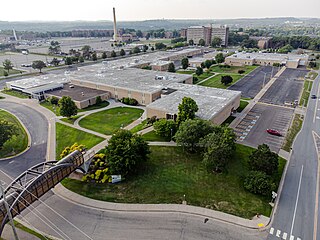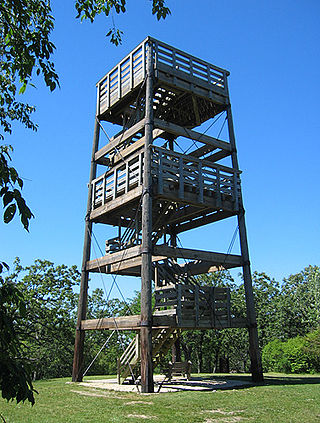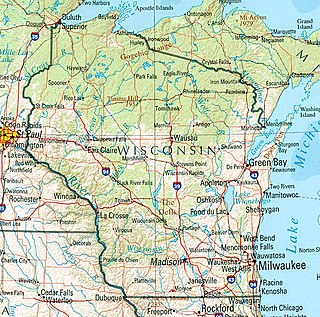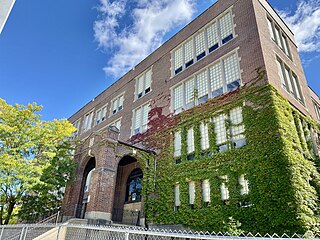
Waukesha County is a county in the U.S. state of Wisconsin. As of the 2020 United States Census, the population was 406,978, making it the third-most populous county in Wisconsin. Its median income of $88,985 placed it as the only county in Wisconsin on the list of the 100 highest-income counties in the U.S. by median income as of 2020. Its county seat and largest city is Waukesha.

The Universities of Wisconsin is a university system of public universities in the U.S. state of Wisconsin. It is one of the largest public higher-education systems in the country, enrolling more than 160,000 students each year and employing approximately 41,000 faculty and staff statewide. The system is headquartered in the state capital of Madison.

Wisconsin has a long history with the Boy Scout and Girl Scout organizations from the 1910s to the present day, both programs have independently served thousands of youth in programs that suit the environment in which they live.
Madison Area Technical College (MATC) or Madison College is a public technical and community college based in Madison, Wisconsin. It serves students in parts of 12 counties in south-central Wisconsin: Adams, Columbia, Dane, Dodge, Green, Iowa, Jefferson, Juneau, Marquette, Richland, Rock, and Sauk.

Chippewa Valley Technical College is one of the 16 technical and community colleges in the Wisconsin Technical College System, centered in Eau Claire, Wisconsin. It serves an 11-county area, with its largest campus in Eau Claire and major regional centers in Chippewa Falls, Menomonie, Neillsville and River Falls.

Lakeland University is a private university with its main campus in Herman, Wisconsin. Lakeland University is affiliated with the United Church of Christ. Lakeland also has seven evening, weekend, and online centers located throughout the state of Wisconsin—in Pewaukee, Madison, Wisconsin Rapids, Chippewa Falls, Neenah, Green Bay, and Sheboygan—and a four-year international campus in Tokyo.

Lakeshore Technical College (LTC) is a public community college in Cleveland, Wisconsin. It is part of the Wisconsin Technical College System. The college offers associate degree and technical diploma programs as well as certifications and adult continuing education programs.

Western Technical College is a public technical college in La Crosse, Wisconsin. A member of the Wisconsin Technical College System, the Western Technical College District serves 11 counties and enrolls over 5,000 students. The college has six campus locations in western Wisconsin and its main campus is in downtown La Crosse. Western is accredited by the Higher Learning Commission.

Lapham Peak is a Wisconsin state park located in the Kettle Moraine State Forest. It is just south of Delafield and seven miles (11 km) west of Waukesha. The park entrance is two miles (3 km) north of the Glacial Drumlin State Trail.

Milwaukee Area Technical College is a public two-year vocational-technical college based in Milwaukee, Wisconsin. MATC offers day, evening, and weekend classes at campuses in downtown Milwaukee, Oak Creek, West Allis, and Mequon. Enrollment is about 35,000. MATC offers over a dozen accredited associate degrees, as well as well over a hundred vocational licenses, job training certificates, and adult enrichment courses. MATC also runs GED and HSED classes at local community-based organizations and offers high school diplomas through its Adult High School program.

Gateway Technical College is a public technical college in southeastern Wisconsin. It is one of the largest members of the state-run Wisconsin Technical College System, serving Kenosha, Racine, and Walworth counties.

Northcentral Technical College (NTC) is a public community college in Wausau, Wisconsin. It is a member of the Wisconsin Technical College System. The district of the college includes all of, or portions of, Marathon, Lincoln, Taylor, Price, Langlade, Menominee, Clark, Portage, Shawano and Waupaca counties. The main campus is located in Wausau. There are regional centers in Antigo, Medford, Merrill, Phillips, Spencer and Wittenberg.

Wisconsin, a state in the Midwestern United States, has a vast and diverse geography famous for its landforms created by glaciers during the Wisconsin glaciation 17,000 years ago. The state can be generally divided into five geographic regions—Lake Superior Lowland, Northern Highland, Central Plain, Eastern Ridges & Lowlands, and Western Upland. The southwestern part of the state, which was not covered by glaciers during the most recent ice age, is known as the Driftless Area. The Wisconsin glaciation formed the Wisconsin Dells, Devil's Lake, and the Baraboo Range. A number of areas are protected in the state, including Devil's Lake State Park, the Apostle Islands National Lakeshore, and the Chequamegon–Nicolet National Forest.

The Wisconsin School for the Blind and Visually Impaired (WSBVI) is a state school that specializes in teaching the visually impaired. It is operated by the Wisconsin Center for the Blind and Visually Impaired (WCBVI), a unit of the Wisconsin Department of Public Instruction. Founded in 1849, the school is located in Janesville, Wisconsin.

The Eau Claire Area School District (ECASD) is a school district in western Wisconsin and the eighth-largest district in the state.

The Madison Vocation School is a Collegiate Gothic-style structure begun in 1921 one block north of the Capitol building in Madison, Wisconsin. In 2019 it was added to the National Register of Historic Places.















